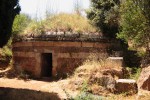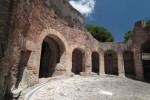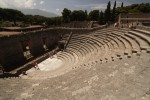Ancient Sites Photo Gallery
|
|
|

Israel, Masada - Remains of a Roman Seige Encampment
|
|

Israel, Masada - Roman Encampment and Seige RampLooking down on the stone wall outlines of one of the Roman encampments (middle upper right) that surrounded the fortress of Masada (another of Herod's Palaces in its glory days). The Roman seige ramp is to the lower left.
|
|

Israel, Masada - The room in which lots were drawnIn this space during archaeological excavations were found eleven ostroca bearing names in Aramaic script. One of eleven inscribed potsherds (ostraca) containing single names, bears in Aramaic script the name ben Ya’ir, undoubtedly Eleazar ben Ya’ir, leader of Masada’s defenders. The historian Josephus relates that when defense against the Romans seemed hopeless, the men at Masada cast lots to decide the order in which they and their families would commit suicide.
Based on the archaeological evidence it is likely that this was the space in which the lots were drawn and the fateful determinations made.
|
|

Israel, Masada - Walls and Roman Seige Ramp in side view
|
|

Israel, Masada - Walls facing the Roman Seige Ramp
|
|

Israel, Megiddo / Jezreel ValleyA view of the Jezreel Valley in the distance looking out from atop Tel Megiddo. The Jezreel Valley will be the site of the final battle between the armies of God and Satan as prophesied in the Book of Revelation. This photo was taken in June 2012 during a two week trip my wife and I took to Israel and Jordan.
cmcdon0923
|
|

Israel, Nazareth - Rolling Stone TombA really well-preserved example of a Jewish rolling-stone tomb. This one is part of a small necropolis which was found underneath the Convent of the Sisters of Nazareth, only a stone’s throw away from the Basilica of the Annunciation. Abu Galyon
|
|

Israel, Qumran - Cave 4Cave 4 was the nearest cave containing documents to the site at Qumran - it’s only about 500 metres away. Most visitors to Qumran take a picture like this one. But mostly they don’t realise that the highly visible cave entrance in their picture is modern, knocked into the side by looters. The ancient entrance to Cave 4 is on the top and well-hidden. Which is perhaps why Cave 4 was found by the local Bedouin, not by Western archaeologists, and why it wasn’t discovered until 1952, over five years after the original manuscript finds of 1946/7. Abu Galyon
|
|

Israel, Qumran - MiqvahThis is L48-49, a water storage feature. The low, plastered partitions on the steps make it likely that this was a miqvah (a ritual bath), rather than a cistern. The damage on the left side of the steps dates from the earthquake of 31 BCE. Abu Galyon
|
|

Israel, Qumran - RefectoryThe ‘Refectory’ (L77) is the largest room at Qumran. A smaller connecting space (L86) nearby contained a huge cache of pottery plates, bowls, and cups. Hence, de Vaux argued that L77 was probably the community’s communal dining room. Abu Galyon
|
|

Israel, Qumran - ScriptoriumL30. From the fill of this room (which came from a collapsed upper level) de Vaux recovered two inkwells and the remains of what appeared to be a long, narrow plastered table (about 480 cm x 40 cm). Another inkwell was found in an adjacent locus. He conjectured that L30 could have been the community’s ‘scriptorium’, a room for copying manuscripts. Abu Galyon
|
|

Israel, Qumran - TowerThe remains of the tower at Qumran. The tower is set in the middle of the north side and has a natural function as an observation or guard tower: north looks towards Jericho, and that would be the natural direction from which travellers would approach the settlement. There is no access to the tower at ground level; instead people would have entered higher up, after climbing a flight of stone steps fixed to the south-side exterior wall. Abu Galyon
|
|

Israel, Scythopolis (Beit She'an)Scythopolis is the only one of the ten ‘Decapolis’ towns situated within the borders of modern Israel. The classical city was destroyed by an earthquake in 749 CE; its ruins are extensive and quite well-preserved. Prominent in the photo is the colonnaded Byzantine ‘Silvanus Street’ (the excavators named it after a local magistrate mentioned in an inscription as responsible for its renewal) which follows the route of the earlier Roman cardo maximus.
Sythopolis was built in the shadow of the earlier Canaanite city of Beit She’an, where (according to 1 Samuel 31) the Philistines, after their victory on Mount Gilboa, displayed the bodies of King Saul and his sons on the city walls. The vast mound of Tel Beit She’an is conspicuous in the background. Twenty settlement strata have been identified there, the earliest dating back to the Neolithic (5th millennium BCE). A section of the eastern Canaanite city walls has also been excavated and is visible in the photo.
Abu Galyon
|
|

Israel, Scythopolis ampitheatreA picture of the ampitheatre in Scythopolis, taken from the top of the even more ancient Beit She'an mound. Running in the foreground is the cardo. This was taken in June 2012 during a two week trip my wife and I took to Israel and Jordan.cmcdon0923
|
|

Israel, Sepphoris - 'Mona Lisa' MosaicPart of a Roman mosaic, usually dated to the early 3rd-century CE, from the dining room floor of a mansion in the upper town at Sepphoris. When it was first excavated, the Israeli press named it 'the Mona Lisa of the Galilee'. Over-hype, maybe, but it is certainly attractive.Abu Galyon
|
|

Israel, The Dome of the Rock on the Temple Mount in the Old City of JerusalemPhoto by Andrew Shiva.Joe Sermarini
|
|

Israel, The HerodiumThe Herodium, 12 km south of Jerusalem, the site of one of Herod's residences and the location of his tomb. The buildings mid-slope to the left of centre are the site of the excavation of Herod's tomb.
|
|

Israel, The Herodium - Summit Interior View
|
|

Israel, The Herodium - Water Cistern
|
|

Israel, The Herodium Pool Complex
|
|

Israel, The Herodium TheatreThe Herodium theatre immediately downslope of Herod's tomb. Sadly it was from this point that Ehud Netzer, the discoverer of Herod's tomb fell to his death in 2010, three years after his epic discovery.
|
|

Israel, Tzipporri - Tzipporri MosaicA mosaic found in Tzipporri, Israel.Aarmale
|
|

Italy, Aquileia - basilicaBasilica is dedicated to the Virgin Mary and the Saints Hermagora and Fortunatus and was built in the first half of the 11th century by Patriarch Poppo in Romanesque style. Upper parts and roof were built by Markward von Randeck in 14th-15th century in Gothic style.
Mosaics from 4th century were hidden under the floor until 1909.J. B.
|
|

Italy, Aquileia - forumJ. B.
|
|

Italy, Aquileia - mosaic floorJonas swallowed by sea monster
Post-Theodorian South hall (end of 4th century)
Mosaics were originally part of Theodorian complex destroyed by Attila. Basilica was built on its site in 1031 and mosaics remained untouched under the floor.J. B.
|
|

Italy, Aquileia - mosaic floorPost-Theodorian South hall (end of 4th century)
Mosaics were originally part of Theodorian complex destroyed by Attila. Basilica was built on its site in 1031 and mosaics remained untouched under the floor.J. B.
|
|

Italy, Aquileia - mosaic floorscene of the Good Shepherd with the Mystic Flock
Christ is portrayed as a beardless young man bearing the lost lamb upon his shoulders. In one hand he holds the syrinx, symbol of the gentless he takes cere of his flock with.
Post-Theodorian South hall (end of 4th century)
Mosaics were originally part of Theodorian complex destroyed by Attila. Basilica was built on its site in 1031 and mosaics remained untouched under the floor.J. B.
|
|

Italy, Aquileia - mosaic floorFishing scene describes the preaching of the Apostles ("Follow me and I will make you fishers of men":Matthew 4,19). The fishes represent the people listening to the good news, the boat is symbol of the church, the net represents the kingdom of heaven ("The kingdom of heaven is like big net that was cast into the sea...": Matthew 13,47).
Post-Theodorian South hall (end of 4th century)
Mosaics were originally part of Theodorian complex destroyed by Attila. Basilica was built on its site in 1031 and mosaics remained untouched under the floor.J. B.
|
|

Italy, Aquileia - mosaic floorRam and battle between Cock and Tortoise. The Cock is symbol of the light of a new day, thus representing Christ, the "light of the world". The tortoise, whose Greek name means "dweller of the darkness", is instead of the symbol of Evil.
Post-Theodorian North hall (middle of the 4th century)J. B.
|
|

Italy, Aquileia - mosaic floorPost-Theodorian North hall (middle of the 4th century)J. B.
|
|

Italy, Aquileia - Roman houseJ. B.
|
|

Italy, Capua - AmphitheatreSpartacus fought there.J. B.
|
|

Italy, Capua - AmphitheatreThe second largest amphitheatre ... arena is only 10m shorter and 8m narrower than colosseumJ. B.
|
|

Italy, Capua - AmphitheatreJ. B.
|
|

Italy, Capua - AmphitheatreJ. B.
|
|

Italy, Cerveteri - Etruscan necropolisTomba dei Rilievi
4th century BCJ. B.
|
|

Italy, Cerveteri - Etruscan necropolisTomba dei Rilievi
4th century BCJ. B.
|
|

Italy, Cerveteri - Etruscan necropolisJ. B.
|
|

Italy, Cerveteri - Etruscan necropolisJ. B.
|
|

Italy, Cosenza, Sibari (Thurium), StreetLucania, Thourioi.
Today Sibari (Cosenza), Italy
|
|

Italy, Ferentium - Roman theatreJ. B.
|
|

Italy, Ferentium - Roman theatreJ. B.
|
|

Italy, Monza, Serpero Museum, Duomo di Monza.Ivory diptych of Stilicho, Roman General (magister militum), Patrician and Consul of the Western Roman Empire. The diptych depicts Stilicho, on the right and, on the left, his wife Serena standing with his son, Eucherius.
The Duomo di Monza is the main religious building of Monza. Although known in English as Monza Cathedral, the building is not in fact a cathedral, as Monza is part of the Diocese of Milan. The church is also known as the Basilica of San Giovanni Battista from its dedication to John the Baptist. In the right transept is the entrance to the Serpero Museum which houses the treasury.*Alex
|
|

Italy, National Museum Naples, Marble bust of Hannibal from CapuaA marble bust, reputedly of Hannibal, originally found at the ancient city-state of Capua in Italy (some historians are uncertain of the authenticity of the portrait). From Phaidon Verlag (Wien-Leipzig) - "Römische Geschichte", gekürzte Ausgabe (1932). Author died more than 70 years ago - public domain.Joe Sermarini
|
|

Italy, Orvieto - Etruscan templeJ. B.
|
|
|
|
|
|
|
|
|

Italy, Ostia - Alexander and Helix's innPosted by Strength And Honour.
Photo taken by my friend Hebe.
|
|
|
|

Italy, Ostia - capitol on forumJ. B.
|
|

Italy, Ostia - CauponaBeautifully preserved, it seems to step back in time.
Posted by Strength And Honour.
Photo taken by my friend Hebe.
|
|

Italy, Ostia - house near forumJ. B.
|
|

Italy, Ostia - house near forumJ. B.
|
|

Italy, Ostia - House of Amor and PsychePosted by Strength And Honour.
Photo taken by my friend Hebe.
|
|

Italy, Ostia - mosaiqueHippocampsJ. B.
|
|

Italy, Ostia - mosaiqueJ. B.
|
|

Italy, Ostia - mosaiqueJ. B.
|
|

Italy, Ostia - mosaiqueJ. B.
|
|

Italy, Ostia - mosaique floorJ. B.
|
|

Italy, Ostia - StreetIt is like stepping back in time....
Posted by Strength And Honour.
Photo taken by my friend Hebe.
|
|

Italy, Ostia - temple of CeresJ. B.
|
|

Italy, Ostia - theatrerebuilt by CommodusJ. B.
|
|

Italy, Paestum, Temple of ApolloFirstly it was thought it's temple of Poseidon, then it's the second temple of Hera and now it's thought it's temple of Apollo. But somewhen temple was used as temple of Poseidon and somewhen as temple of Hera.
Who knows how many times temple will change deity in future.
Temple was built +- 450 BCJ. B.
|
|

Italy, Paestum, Temple of ApolloFirstly it was thought it's temple of Poseidon, then it's the second temple of Hera and now it's thought it's temple of Apollo. But somewhen temple was used as temple of Poseidon and somewhen as temple of Hera.
Who knows how many times temple will change deity in future.
temple was built +- 450 BCJ. B.
|
|

Italy, Paestum, Temple of Athenagreek colony Poseidonia
built +- 500 BCJ. B.
|
|

Italy, Paestum, Temple of Athenagreek colony Poseidonia
built +- 500 BC
this temple was used as church but temple of Apollo and Hera weren't.J. B.
|
|

Italy, Paestum, Temple of Heragreek colony Poseidonia
temple built +- 550 BCJ. B.
|
|

Italy, Palestrina, Ruins of the Sanctuary of Fortuna Primigeniahttp://en.wikipedia.org/wiki/PalestrinaJoe Sermarini
|
|

Italy, Piombino, Museo Archeologico del Territorio di PopuloniaAmphora of barrati, a amphora totally of silver found in the sea near Piombino
|
|

Italy, Piombino, Museo Archeologico del Territorio di PopuloniaPart of a coin deposit found in the sea near the beach of Populonia, totally weight 17 kg, now in the museum of Piombino in an aquarium. The hoard consists of Antoninians of the third century.
|
|

Italy, Piombino, Museo Archeologico del Territorio di PopuloniaGold found in graves of the ancient etruscan Populonia
|
|

Italy, PompeiiA well-known mosaic in an entryway of an affluent household, but it still never fails to please :-) July 2008Mark Z
|
|

Italy, Pompeii - AmphitheatreJ. B.
|
|

Italy, Pompeii - bakeryHere's a bakery, complete with oven. When this was unearthed, there were several loaves of bread inside, intact, but a little overdone ;-) July 2008Mark Z
|
|

Italy, Pompeii - bathInside the public bathhouse. Much like the "Occulus" in the Pantheon, the window to the upper left is the only light source in the room.Mark Z
|
|

Italy, Pompeii - cemetaryJ. B.
|
|

Italy, Pompeii - ForumJ. B.
|
|

Italy, Pompeii - ForumJ. B.
|
|

Italy, Pompeii - graffitiAncient graffiti (gladiator standing left) on a wall. Visitors can walk right up and touch it. July 2008Mark Z
|
|

Italy, Pompeii - modest villaInside one of the more modest villas in Pompeii, although you'd never know it by the still-beautiful murals on the walls and the fountain there to the right.Mark Z
|
|

Italy, Pompeii - OdeonJ. B.
|
|

Italy, Pompeii - residential streetOne of the numerous residential streets in Pompeii. July 2008Mark Z
|
|

Italy, Pompeii - storage at forumJ. B.
|
|

Italy, Pompeii - streetAnother great shot of another street in Pompeii. The stepping stones in the foreground can be found all around the city. As I'm sure you know, water ran constantly through the streets, and pedestrians used these stepping stones to keep their feet dry.Mark Z
|
|

Italy, Pompeii - temple of ApolloJ. B.
|
|

Italy, Pompeii - Vesuv in the backgroundJ. B.
|
|

Italy, Pompeii - victims of Mt. Vesuvius in 79 AD.One of the unfortunate victims of Mt. Vesuvius in 79 AD.Mark Z
|
|
|
|
